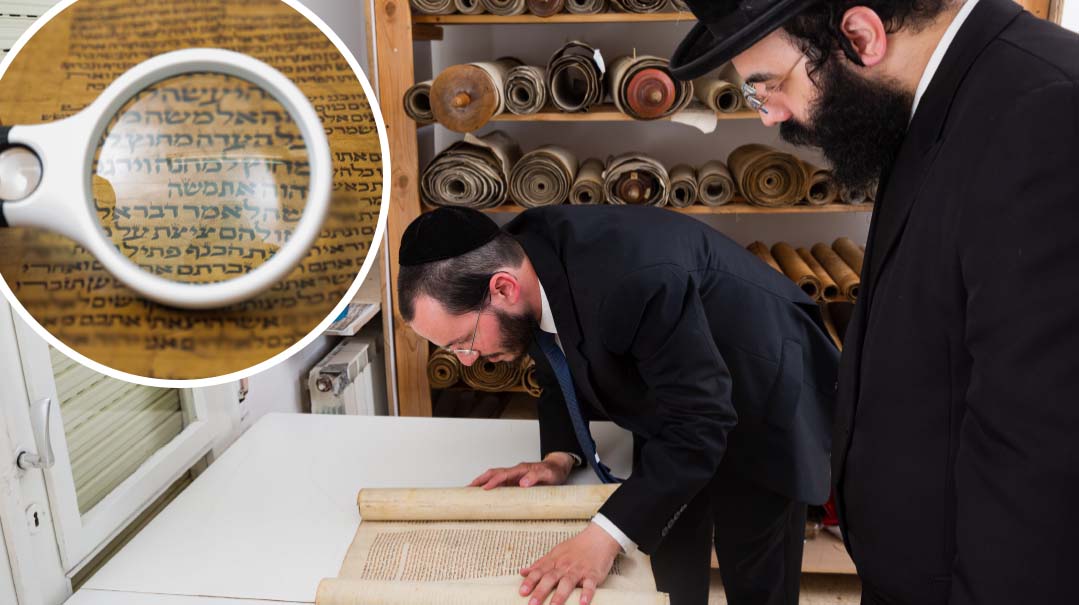Scroll Up

Hundreds of fragments of sifrei Torah from different lands and many eras — all waiting to be studied and analyzed

"Reb Yehoshua, maybe you can help me.”
The man on the other end of the line sounded miserable. He was an elderly Persian dealer in sifrei Torah who would buy used scrolls, refurbish them, and resell them from his Meah Shearim storefront, but now he was stuck. He’d just spent a considerable sum on a sefer Torah an agent had assured him was a rare antique, but one interested buyer took a look and pronounced, “Something here doesn’t look right.”
The dealer called Rabbi Yehoshua Yankelewitz, an expert on sifrei Torah and the most arcane details of the world of sta”m, asking him if he could give the sefer Torah a look.
“It took me three minutes to determine that the sefer Torah was a fraud,” says Rabbi Yankelewitz. “The seller had expertly sewn together the yerios of various sifrei Torah that he’d acquired from a bunch of different locations and communities and passed it off as a valuable antique.”
The dealer despaired at all that lost money — but then Rabbi Yankelewitz threw him off guard with an unexpected offer to purchase it. The dealer was thrilled to recoup his thousand dollars after learning that the sefer Torah wasn’t worth anything as an antique, and Rabbi Yakelewitz had hit the jackpot too.
“This conman thought he was ripping off the dealer, but instead he had brought together perfect materials for my collection: dozens of yerios from around the world.”
When the dealer saw how happy Rabbi Yankelewitz was with this new find, he upped his price to $3,500. In the end, both of them got their treasure.

The Newer the Better
A person like Young, energetic Yehoshua Yankelewitz isn’t exactly who comes to mind when you envision a world expert on sifrei Torah and the halachic development of various scripts, or ksavim. He’s no stodgy, hunched-over collector, but a 30-something, friendly, and outgoing American avreich living in Bayit Vegan who takes the Jerusalem light rail to and from his kollel in the Old City every day. He also gives tours of the Old City, and runs a camp for American yeshivah boys every summer. Collecting scrolls, he says, “is really just my hobby.”
It’s a “hobby” that has taken over much of his life and garnered the attention of talmidei chachamim all over who are involved in sta”m and the halachic aspects of writing. Yet Rabbi Yankelewitz isn’t necessarily looking for antique treasures or whole ancient Torah scrolls. He’ll pounce on a piece of parchment of any sefer Torah, Megillah, or Navi scroll over a hundred years old, and he collects them from around the world. His gallery, he says, is really a service for scholars, who are invited to peruse the collection.
“They can sit there for hours studying what I have,” he says, explaining that his finds aren’t generally ancient collectors’ items, because that’s not his purpose. His purpose, he says, is to provide a real service to talmidei chachamim and students of sta”m. He prefers not to publicize the exact location or too many other technical details of the temperature-controlled, secured storeroom where his treasures rest , although it’s accessible to both scholars and laymen.
“An ancient sefer Torah might be valuable for a collector and would definitely give me great bragging rights, but a talmid chacham learning halachos of sta”m can’t put the kind of scroll into context because it’s so radically different. However, if you study a sefer Torah similar to today’s but written, say, 100 years ago in Gemany, you have something concrete to compare it to and can put it in a halachic context — the slight differences you can learn from, the radical differences you don’t really have a context for.”
His collection, interestingly, contains hundreds of folios of parchment but few complete sifrei Torah (although he somehow managed to acquire one complete sefer Torah thought to be written by the 17th-century Gedulei Terumah), and definitely nothing that would be kosher for Krias HaTorah.
“That’s because this collection isn’t a museum,” Rabbi Yankelewitz explains. “It’s really an educational center, the purpose of which is to reach a better understanding of the halachos of writing sifrei Torah and the opinions of the poskim over the generations.”
The yerios he’s collected come from an enormous range of kehillos, communities, and regions: Spain, Greece, Galicia, Germany, Yemen, Morocco, Bukhara, and on and on. Each yeria has its own unique attributes, including the style of calligraphy, the quality of the klaf, and the processing methods.
Oops! We could not locate your form.







